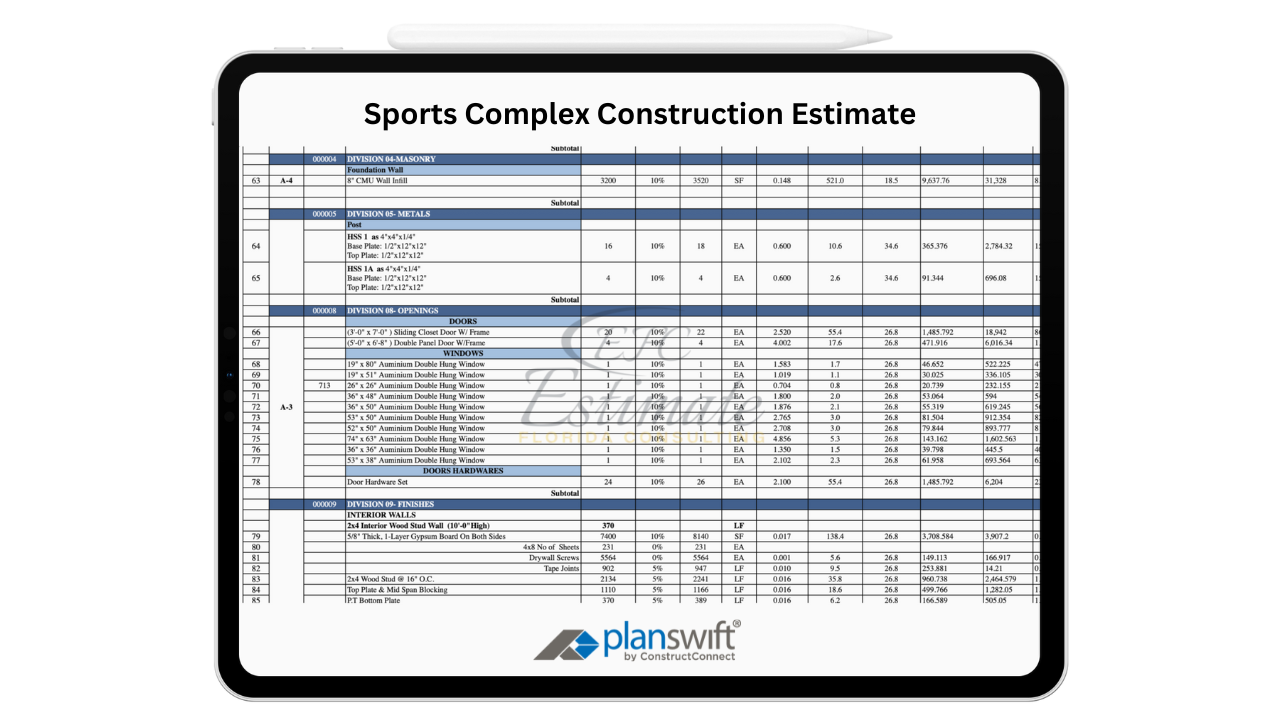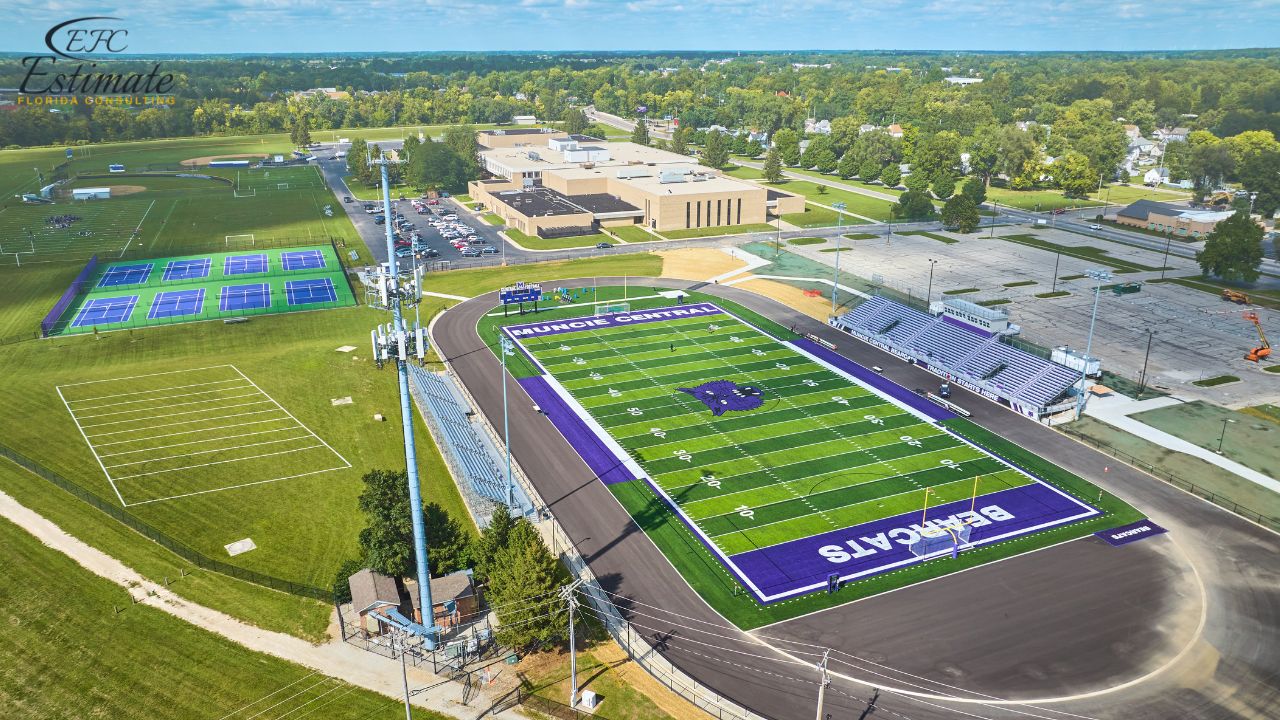- Homepage
- Construction in Key Biscayne
Sport Complex Construction in Key Biscayne
Leading provider of sports complex construction services.
Key Biscayne, a luxury seaside village in Miami-Dade County, is witnessing rising demand for world-class sports and recreation infrastructure. With increased interest from developers, municipalities, and private institutions, constructing a modern sports complex in this exclusive coastal area presents a lucrative opportunity. However, it also involves navigating strict regulatory requirements, advanced design considerations, and elevated construction costs. This comprehensive guide by Estimate Florida Consulting outlines the estimated construction costs, facility options, planning phases, and real-world insights for building a state-of-the-art sports complex in Key Biscayne, Florida.

Average Cost to Build a Sports Complex in Key Biscayne
The cost to construct a sports complex in Key Biscayne varies significantly based on the type of facilities included, the location’s regulatory demands, and the scale of development. Due to Key Biscayne’s location in a hurricane-prone and flood-risk zone, structures must be built with advanced engineering systems, impact-resistant materials, and flood elevation compliance. This adds to the base construction costs, making such developments premium investments in terms of both functionality and compliance.
Facility Type | Estimated Cost per Sq. Ft. |
Outdoor Fields (Basic Turf) | $28 – $52 |
Outdoor Fields (Synthetic Turf) | $48 – $80 |
Indoor Gymnasium | $175 – $280 |
Indoor Multi-Sport Arena | $220 – $350+ |
Olympic-Size Swimming Pool | $1.8M – $4.2M |
Cost Per Square Foot by Component
Component | Cost Per Sq. Ft. |
Structural Steel Framing | $45 – $80 |
Roofing (Metal or Membrane) | $20 – $35 |
HVAC & Ventilation Systems | $18 – $32 |
Lighting (LED Sports Rated) | $14 – $28 |
Flooring (Hardwood/Gym Turf) | $15 – $38 |
Bleachers & Seating | $100 – $180 per seat |
Cost Per Square Foot by Facility Type
The price per square foot for each part of the sports complex depends on material selection, structural complexity, and mechanical systems. For example, arenas and gymnasiums demand higher ceiling heights and ventilation requirements. A well-finished indoor basketball court, for instance, will cost significantly more than a simple synthetic turf field due to specialized flooring, lighting, and HVAC demands.

Site Development and Coastal Code Requirements
Key Biscayne enforces rigorous coastal construction standards designed to mitigate flood risk and protect sensitive shorelines. Any new development must comply with the Coastal Construction Control Line (CCCL), which governs building elevation, sea wall design, and land disturbance limitations. Additional permitting may be needed for shoreline protection, environmental reviews, and soil stability improvement.
Key requirements include:
- Coastal Construction Control Line (CCCL) certification
- Elevated foundations to meet FEMA flood regulations
- Erosion control and drainage systems
- Environmental impact assessments and approvals
Site prep and permitting costs: $150,000 – $450,000+
90% More Chances to Win Sports Complex Bids with Our Estimate!
Indoor vs Outdoor Complex Cost Comparison
Type | Pros | Cost Estimate (Total) |
Indoor Complex | Year-round usage, climate controlled, flexible use | $4M – $10M+ |
Outdoor Fields | Lower cost, natural lighting, less MEP systems | $1.2M – $3.5M |
Indoor facilities offer all-weather usability, increased programming flexibility, and year-round revenue generation from memberships and rentals. Outdoor complexes cost less but require more maintenance and are more exposed to environmental elements.
Athletic Surfaces and Material Costs
Athletic surfaces and material costs vary based on the type of sport, climate, and budget. For example, indoor courts typically use hardwood or synthetic flooring like polyurethane for shock absorption and durability. Running tracks often feature rubberized surfaces, providing optimal traction and injury prevention. Multi-purpose gym floors may use vinyl or modular tiles for flexibility and cost-efficiency. Material selection also influences long-term maintenance costs—synthetic surfaces offer longer lifespans but come with higher upfront costs, while natural options may require frequent care and repairs. Proper planning ensures both performance and cost-effectiveness.

Surface Type | Cost per Sq. Ft. |
Natural Grass Field | $6 – $12 |
Artificial Turf Field | $10 – $20 |
Hardwood Basketball Floor | $12 – $18 |
Rubberized Track Surface | $15 – $25 |
Tennis/ Pickleball Courts | $45,000 – $85,000+ |
HVAC, Lighting, and Sports Equipment Estimations
Climate-controlled buildings require substantial investment in commercial HVAC systems, particularly in Florida’s hot and humid climate. Lighting and audio systems tailored to sporting environments also add to the capital cost.
System/Equipment | Estimated Cost |
Commercial HVAC for Arena | $250,000 – $600,000 |
LED Sports Lighting Systems | $120,000 – $280,000+ |
Scoreboards & Sound Systems | $50,000 – $130,000 |
Retractable Bleachers (per set) | $18,000 – $32,000 |
3D Rendering Cost for a Sports Complex In Key Biscayne
The cost of 3D rendering for a sports complex depends on factors such as project size, level of detail, rendering quality, and turnaround time. Basic exterior renderings may start at $1,000 to $3,500, while high-quality, photorealistic 3D renders with interiors can range from $5,000 to $25,000 or more. Custom animations, VR walkthroughs, and interactive presentations can further increase costs. Hiring experienced 3D artists or agencies ensures precision, realistic visuals, and effective project execution.
We Provide 3D Rendering Services!
For Sports Complex and Other Projects
Turnaround time is 1-2 days.
Win More Projects With Us
Synthetic Turf vs Natural Grass Fields
Surface Type | Installation Cost | Maintenance Cost |
Synthetic Turf | $9 – $15 per sq. ft. | $6,000 – $10,000/year |
Natural Grass | $4 – $8 per sq. ft. | $15,000 – $25,000/year |
Locker Rooms, Office, and Amenity Spaces
Support facilities such as locker rooms and administrative offices are essential for the daily operations of a sports complex. They also contribute to the user experience and help boost revenue potential by supporting premium services.
- Locker Rooms: $350 – $500 per sq. ft. (includes showers, ventilation, lockers)
- Fitness Center: $200 – $320 per sq. ft.
- Café or Concession Stand: $100,000 – $180,000
- Office/Admin Space: $180 – $280 per sq. ft.
- Storage Rooms and Equipment Lockers: $150 – $240 per sq. ft.
Parking Lots and External Facility Development
- Key Biscayne projects must also allocate funds for high-quality exterior elements including:
- Parking lot paving and striping ($6 – $10 per sq. ft.)
- Landscaping and tree protection ($40,000 – $120,000)
- Exterior lighting and signage ($25,000 – $60,000)
- ADA compliance walkways and ramps ($20,000+ depending on layout)

Green Building Features and Energy Efficiency
Adding sustainable features like solar panels, energy-efficient HVAC, and recycled materials can reduce long-term operating costs while qualifying for green building certifications such as LEED or Florida Green. Although these features increase initial capital costs by 10–15%, they result in long-term operational savings and positive community impact.
Accessibility and Universal Design Standards
Ensuring ADA compliance and integrating universal design is critical for accommodating all users, including individuals with disabilities. Features include accessible seating, ramps, elevators, restrooms, and wayfinding systems.
Safety Regulations and Fire Compliance
Sports complexes must adhere to local fire safety regulations, including:
- Sprinkler systems
- Emergency lighting and exits
- Fire alarms and smoke detectors
- Annual fire code inspections
Estimated Fire Safety Installations: $80,000 – $200,000
90% More Chances to Win Projects With Our Estimate!
- Multi-Family Building
- Hotel Building
- Hospital Building
- Warehouse Building
- School & University Building
- High-Rise Building
- Shopping Complex
- Data Center Building

Maintenance & Long-Term Operating Costs
A well-maintained facility ensures player safety, prolonged life of sports surfaces, and continued visitor satisfaction.
Category | Annual Cost Estimate |
Field Maintenance | $25,000 – $55,000 |
HVAC and Lighting Upkeep | $15,000 – $30,000 |
Equipment Replacement | $10,000 – $20,000 annually |
Security & Staffing | $100,000+ per year |
Landscaping & Pest Control | $15,000 – $25,000 |
Project Timeline & Phased Construction Approach
Typical construction timelines range from 12 to 24 months, depending on project scale. Many developers opt for phased construction:
- Phase 1: Site development, outdoor fields
- Phase 2: Indoor arenas, locker rooms
- Phase 3: Admin offices, fitness centers, and amenities

Community Engagement and Educational Partnerships
Key Biscayne sports complexes can benefit from partnerships with local schools, universities, and youth organizations. These collaborations help drive traffic to the facility and promote health and wellness initiatives across the community.
Zoning Laws and Approval Timeline
Key Biscayne requires multiple zoning reviews and planning board approvals. This includes:
- Environmental impact reports
- Noise and traffic studies
- Public hearing sessions
Zoning and permit approval can take 6–12 months and should be factored into the project schedule.
Choosing the Right Construction Partner in Key Biscayne
Hiring a local firm with experience in Florida building codes and coastal development is essential. Estimate Florida Consulting provides:
- Comprehensive cost estimation
- Value engineering suggestions
- Contractor and subcontractor selection
- Permit assistance and scheduling support
Role Of Professionals for Sports Complex Construction in Key Biscayne
- Contractors: Manage the entire sports complex construction project, ensuring high-quality work, overseeing materials, labor, and schedules while complying with Key Biscayne building codes and safety regulations. Hiring experienced contractors ensures smooth project execution.
- Subcontractors: Handle specialized tasks such as lighting installation, turf or court surfacing, HVAC systems, and structural reinforcements to enhance durability and efficiency. Skilled subcontractors are essential for building high-performance sports facilities.
- Architects: Design modern, functional, and energy-efficient sports complexes that maximize space, ensure athlete safety, and comply with Key Biscayne’s building regulations. Professional architects help create visually appealing and practical sports facilities.
- Engineers: Ensure the structural stability, safety, and efficiency of sports complexes by overseeing mechanical, electrical, and civil components. Expert engineers play a crucial role in constructing sustainable and resilient sports venues in Key Biscayne.
- Construction Estimators: Provide accurate cost assessments for materials, labor, and project timelines to help optimize budget planning and prevent cost overruns. Hire professional estimators to ensure financial efficiency and project feasibility.
Get 5 New Projects in the Next 7 Days With Our System
Conclusion
Building a sports complex in Key Biscayne is a high-investment venture that offers significant rewards through community engagement, recreational development, and long-term revenue generation. However, success lies in careful planning, proper budgeting, and working with experienced professionals familiar with Florida’s regulatory and environmental complexities.
Question Answer
Frequently Asked Question
A sports complex typically includes multiple athletic facilities such as indoor gyms, football or soccer fields, running tracks, basketball and tennis courts, locker rooms, training zones, restrooms, seating areas, lighting systems, and parking.
They are developed by municipalities, private sports organizations, schools, universities, clubs, and commercial investors looking to create revenue-generating recreational hubs.
Outdoor complexes (football fields, running tracks, baseball diamonds)
Indoor facilities (basketball, volleyball, gymnasiums)
Multi-sport domes or covered arenas
Aquatic centers
Fitness and training centers
Community recreational sports parks
Turf & Flooring: Synthetic turf, polyurethane, hardwood, rubberized flooring
Structures: Steel frames, pre-engineered buildings (PEBs), tilt-up concrete
Roofing: Tensile membrane roofs for domes, standing seam metal
Lighting: LED stadium lighting, motion-activated systems
HVAC & Ventilation: Essential for indoor sports venues
Yes. Modern facilities incorporate solar panels, LED lighting, rainwater harvesting, HVAC zoning, low-flow plumbing, and high-performance insulation for sustainability and LEED compliance.
Absolutely. Many complexes include food courts, merchandise stores, lounges, and co-working spaces to enhance user experience and generate extra revenue.
Construction Professionals For Your Project?
- Electrical
- Plumbing
- Masonry
- Roofing
- Painting
- More

